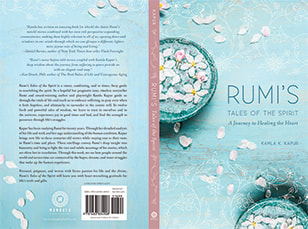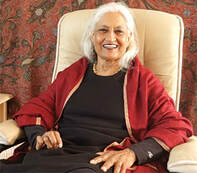LOS ANGELES, CA - Indian-American author Kamla K Kapur based out of Southern California, is the author of `Rumi’s Tales from the Silk Road: Pilgrimage to Paradise.’ Her new book on Rumi, `Rumi, Tales of the Spirit: Journey to Healing the Heart,’ was published in South East Asia in September 2017. It will hit book stands in the US in March 2019. Here are excerpts from an interview with Kapoor on her new book. Q: You have written several books from several traditions – the Hindu, the Sufi, the Sikh:
For some of us, like me, these familial loyalties are arrived at after a lot of detours, a lot of searching elsewhere.
I explored every religion I came across and realized that there was something I liked about each of them. I have always been a lover of mythology, both Eastern and Western, and this particular passion made me turn first to Hinduism’s rich tapestry of spiritual stories from the Mahabharata, the Ramayana, the Puranas, stories that are in my blood as an Indian. I reinvented them in `Ganesha Goes to Lunch’ (Classic Tales from Mystic India, 2007).
Then I turned to Rumi with a passion when I first discovered the `Mathnavi,’ translated by Reynold A. Nicholson. Rumi’s stories are no less engaging than any in the Hindu tradition, and no less powerful in their ability to enlighten us by lessening the baggage of our minds. My first book on Rumi, `Rumi’s Tales from the Silk Road’ (2009), recreates and develops 32 of his stories for a modern audience. I have always wanted to write commentaries and essays on these stories to relate them to our lives and psyches today, and when Jaico Publishing offered me an opportunity to do so two years ago, I jumped at it. The book, `Rumi, Tales to Live By’ was published in 2017 in India, and the same book is being launched in the US in March 2019 under the title` Rumi’s Tales of the Spirit, Journey to Healing the Heart.’
The commentaries bring to light wisdom -- survival tools -- from all traditions: Hindu, Jewish, Islamic, Christian, Buddhist and Sikh, address themselves to our anxieties and sufferings today.
But since you asked me which of these traditions I identify with most, I have to say in all honesty, Sikhism. Why? Because Sikhism, in its basic, fundamental form and faith, embraces the others as well. The Sikh holy book, The Granth Sahib contains many compositions of Sufi and Hindu saints from all castes and classes. If Indian mythology and Rumi have spoken to me in prose, Sikhism has spoken to me through song. That is why I began to write the Sikh Saga Series, the first book, `The Singing Guru,’ centered around Guru Nanak, followed by `Into the Great Heart’(2018), about Guru Nanak and Guru Angad. A third book in the series is underway.
So, in a way my faith includes all religious traditions of the world, including pagan and non-theistic points of view. I think in this multi-partisan world what we need most is a vision of the truth of every tradition, of that democracy that excludes none, regardless of religion or lack thereof, caste, class, color, gender or lack thereof. This democracy is inbuilt into Sikhism, though it is only the rare Sikh that adopts and practices this vision of the gurus.
Q: Why the story form?
A. The writer in me worships the power of stories to impart wisdom to every age in our history as human beings. Stories have survived from our very beginnings as conscious human beings precisely because of their ability to instruct through entertainment, impart wisdom that is crucial for our survival both as individuals and as a species.
Q: If you identify yourself as a Sikh, how come `The Singing Guru’ was your third book of stories from different traditions?
A.I hesitated so long to write it because history, not story comprises a large part of the way Sikhism is practiced today. History, facts, dates, true events, biography serves its purpose and is no less a survival tool for a group and tribe. Being conscious of history can ensure it isn’t repeated again. Sikhs glorify, seek to remember and gain strength from their history, just like the other persecuted minority, Jews: Remember the holocaust! Remember Aurangzeb! Remember 1984! Don’t let it happen ever again!
Though the human in me “passionately prefers” (in Robert Frost’s phrase) Sikhism, the writer in me is not comfortable with the constraints that Sikhism as it is practiced today imposes on its adherents. Especially, I would say, their resistance to personification. It took a lot of struggle to choose to fictionalize the Sikh stories I loved, to personify Guru Nanak and his minstrel, and show them in a human light. We, material creatures of the senses, need representation, images, symbols. There can be no religion, and certainly no art without them. Imagination, images, invention is the very lifeblood of art. History that is not reinterpreted in each age stagnates and fossilizes a living faith. As a writer I must be free to reimagine the skeleton of history, give it flesh and breath in order to bring it alive. A writer can have no restraints with her material. Freedom is the very ground and soil of all art.
Q What would you say is the main difference between your first and second book on Rumi?
A.I think the real difference is that a lot of suffering happened in the interim! My suffering allowed me to see Rumi’s stories and words in a new light. Suffering, both Guru Nanak and Rumi say, is a gift that bestows many treasures. Above all, suffering changes our perspective on life, ourselves, others, and teaches us ways of being, thinking and living that are so much healthier and fulfilling.
I explored every religion I came across and realized that there was something I liked about each of them. I have always been a lover of mythology, both Eastern and Western, and this particular passion made me turn first to Hinduism’s rich tapestry of spiritual stories from the Mahabharata, the Ramayana, the Puranas, stories that are in my blood as an Indian. I reinvented them in `Ganesha Goes to Lunch’ (Classic Tales from Mystic India, 2007).
Then I turned to Rumi with a passion when I first discovered the `Mathnavi,’ translated by Reynold A. Nicholson. Rumi’s stories are no less engaging than any in the Hindu tradition, and no less powerful in their ability to enlighten us by lessening the baggage of our minds. My first book on Rumi, `Rumi’s Tales from the Silk Road’ (2009), recreates and develops 32 of his stories for a modern audience. I have always wanted to write commentaries and essays on these stories to relate them to our lives and psyches today, and when Jaico Publishing offered me an opportunity to do so two years ago, I jumped at it. The book, `Rumi, Tales to Live By’ was published in 2017 in India, and the same book is being launched in the US in March 2019 under the title` Rumi’s Tales of the Spirit, Journey to Healing the Heart.’
The commentaries bring to light wisdom -- survival tools -- from all traditions: Hindu, Jewish, Islamic, Christian, Buddhist and Sikh, address themselves to our anxieties and sufferings today.
But since you asked me which of these traditions I identify with most, I have to say in all honesty, Sikhism. Why? Because Sikhism, in its basic, fundamental form and faith, embraces the others as well. The Sikh holy book, The Granth Sahib contains many compositions of Sufi and Hindu saints from all castes and classes. If Indian mythology and Rumi have spoken to me in prose, Sikhism has spoken to me through song. That is why I began to write the Sikh Saga Series, the first book, `The Singing Guru,’ centered around Guru Nanak, followed by `Into the Great Heart’(2018), about Guru Nanak and Guru Angad. A third book in the series is underway.
So, in a way my faith includes all religious traditions of the world, including pagan and non-theistic points of view. I think in this multi-partisan world what we need most is a vision of the truth of every tradition, of that democracy that excludes none, regardless of religion or lack thereof, caste, class, color, gender or lack thereof. This democracy is inbuilt into Sikhism, though it is only the rare Sikh that adopts and practices this vision of the gurus.
Q: Why the story form?
A. The writer in me worships the power of stories to impart wisdom to every age in our history as human beings. Stories have survived from our very beginnings as conscious human beings precisely because of their ability to instruct through entertainment, impart wisdom that is crucial for our survival both as individuals and as a species.
Q: If you identify yourself as a Sikh, how come `The Singing Guru’ was your third book of stories from different traditions?
A.I hesitated so long to write it because history, not story comprises a large part of the way Sikhism is practiced today. History, facts, dates, true events, biography serves its purpose and is no less a survival tool for a group and tribe. Being conscious of history can ensure it isn’t repeated again. Sikhs glorify, seek to remember and gain strength from their history, just like the other persecuted minority, Jews: Remember the holocaust! Remember Aurangzeb! Remember 1984! Don’t let it happen ever again!
Though the human in me “passionately prefers” (in Robert Frost’s phrase) Sikhism, the writer in me is not comfortable with the constraints that Sikhism as it is practiced today imposes on its adherents. Especially, I would say, their resistance to personification. It took a lot of struggle to choose to fictionalize the Sikh stories I loved, to personify Guru Nanak and his minstrel, and show them in a human light. We, material creatures of the senses, need representation, images, symbols. There can be no religion, and certainly no art without them. Imagination, images, invention is the very lifeblood of art. History that is not reinterpreted in each age stagnates and fossilizes a living faith. As a writer I must be free to reimagine the skeleton of history, give it flesh and breath in order to bring it alive. A writer can have no restraints with her material. Freedom is the very ground and soil of all art.
Q What would you say is the main difference between your first and second book on Rumi?
A.I think the real difference is that a lot of suffering happened in the interim! My suffering allowed me to see Rumi’s stories and words in a new light. Suffering, both Guru Nanak and Rumi say, is a gift that bestows many treasures. Above all, suffering changes our perspective on life, ourselves, others, and teaches us ways of being, thinking and living that are so much healthier and fulfilling.



 RSS Feed
RSS Feed
